J Zentmayer Phila Antique Brass Us Army Hospital Microscope S/n-453, Circa 1870
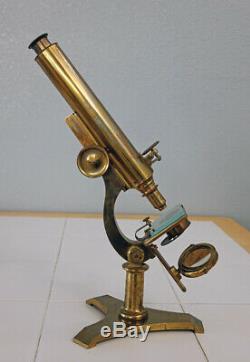
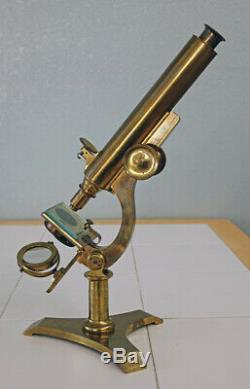
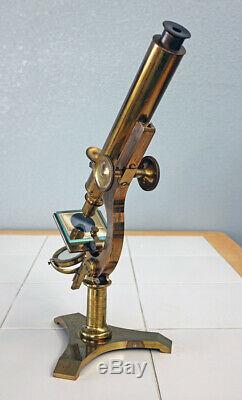

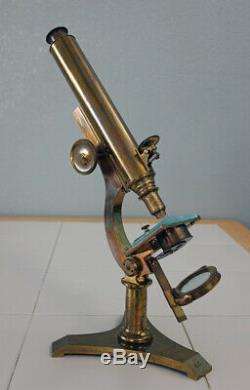


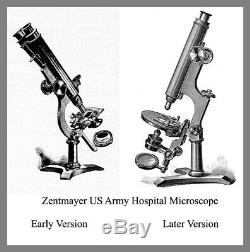
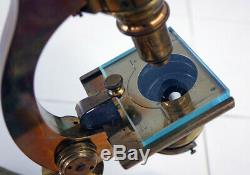
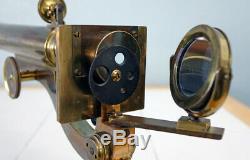
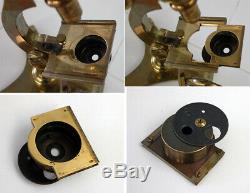
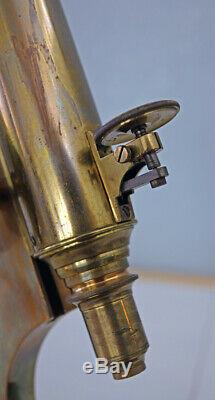

J ZENTMAYER PHILA ANTIQUE BRASS US ARMY HOSPITAL MICROSCOPE S/N-453, CIRCA 1870. JOSEPH ZENTMAYER ANTIQUE BRASS EARLY U. ARMY HOSPITAL MICROSCOPE S/N-453 Circa 1870. Featured here is a very nice example of Zentmayers famous United States Army Hospital Microscope.
It is also identified in some of the Zentmayer microscope catalogues as his microscope Stand No. It was the first microscope model designed especially for use in wartime field hospitals beginning with the US Civil War era. Joseph Zentmayer is identified as the maker of this instrument as it is signed, J. Zentmayer, Philadelphia, in fancy script on the top of one of the tripod feet (see close-up image). This instrument also bears a relatively low serial number - 453.
Zentmayer first introduced this model microscope in the year 1862. The US Government was in urgent need of microscopes for use in military hospitals during the Civil War. Zentmayer, being one of only four American microscope manufacturers at that time, was called upon to supply quality instruments to the Union Army. This stand proved to be very successful ultimately becoming his most popular model microscope, and was made by Zentmayer himself and later by his sons that succeeded him until the end of the 19th Century. NOTE: For more on the history of the Zentmayer optical firm, please see below. When this hospital model was first made it had a tripod base, a single pillar, a classic curved Lister arm or limb, a single milled head pinion operating a horizontal rack for coarse focusing, a body tube without a drawtube and a short-lever fine focusing unit mounted on the front of the lower body tube. Subsequent model changes included a double milled head pinion for coarse focusing (circa 1870), an optional binocular body tube (circa 1875), a patented swinging substage mirror assembly in 1876, an angular Jackson type limb with through the limb long-lever fine focus mechanism (circa 1880) and finally a continental style horseshoe base (circa 1885). The nature of these periodic changes amount to a complete redesigning of the instrument over a period of some 23 years.Accompanying this listing are images of both his earlier and his later versions of his US Army Hospital Microscope that illustrate these changes in the instrument over time. Due to the fact that this instrument features a tripod base with single pillar, the curved Lister arm and dual milled head pinions for coarse focus, a body tube without a drawtube, along with a relatively low serial number of 453, we can clearly identify this particular example as one of Zentmayers earliest examples of the US Army Hospital Microscope. Thus, this instrument most likely dates from circa 1870.
It is of interest that this microscope model was specifically designed for use in wartime field hospitals beginning with the US Civil War period. It was related to the contemporaneous rise of the germ theory of disease espoused by such notable scientists as John Snow and Louis Pasteur of the late 1850s. Although not specifically designed as a field microscope in the traditional sense, this is the first microscope model ever to be designed specifically for use in front-line wartime hospitals. One can imagine this microscope model being used by a physician in a hospital tent near the front lines to identify the nature of a bacterial infection in the wound of a soldier. Thus, it represents a significant milestone in the history of the development of microscopes for specific purposes.As such, this antique brass microscope will make an outstanding addition to any antique microscope collection, especially one that has an emphasis on American made instruments designed for a specific use. This US Army Hospital Microscope is built upon a brass tripod foot with a single brass pillar that rises to a compass joint.
This joint permits all degrees of inclination of the microscope from the perpendicular to the horizontal. Also affixed at the joint and rising upward from this point is nicely curved Lister limb. The limb, in turn, supports the stage, substage mirror assembly, and the body tube along with the course and fine focus mechanisms.
Mechanically attached to the top leading edge of the limb is a 65mm x 72 mm rectangular stage of this instrument. Integral with the stage is a dovetail-mounted central segment that features a rotating disc of apertures. This dovetail-mounted unit can be removed from the instrument if desired (Please see the accompanying composite image that clearly shows this unique feature).On the top of the stage is a glass stage plate, but missing is a moveable slide holder that is not included with this particular instrument. Attached to the lower edge of the leading edge of the limb is a brass mirror bar that can be moved laterally from side to side.
Mounted on this bar is a yoke-mounted 42mm diameter plano-concave mirror on a dovetail assembly that allows it to be moved along the bar either closer to or away from the stage. Affixed to the body tube of the microscope is a tapered male bar track with a rack that fits into a female receptor channel on the forward face of the curved limb. It is of interest that the rackwork on this microscope is horizontal in nature and not angled. Swift & Son invented angled rackwork in Europe in the year 1882/83 and it took a number of years before American microscope makers adopted its use on their instruments. Thus, this is another indication that this microscope was likely manufactured in circa 1870. A pinion gear assembly with a pair of brass milled heads is housed in a brass gearbox placed in the middle of the upper lineal section of the limb. It engages the rackwork and controls the coarse focus of the body tube. Fine focus is by the previously mentioned short lever mechanism found on the lower front of the body tube. Control of the fine focus is by means of a brass micrometer knob found on the front of the body tube. The body tube of this microscope is of unitized construction and does not include a conventional drawtube. A single objective lens with RMS threads is found at the base of the body tube. It too is unmarked also typical of Zentmayers objectives. It appears to be his 8/10-Inch low power objective. When the body tube is racked down to its lowest level with the eyepiece removed from the body tube, this microscope stands about 14 inches tall (as measured from the base of the foot to the top of the body tube).When instrument is set up for observations with the eyepiece in place, the microscope stands about 16 inches tall. The microscope weighs about 6 pounds. There is no wood case or other accessories that accompany this microscope. NOTE: The accompanying images, which were captured under ambient light conditions, are a part of this condition statement.
Please take the time to view all of the images so you can confirm the condition of the microscope and so you will know exactly what you will be getting should you be the very fortunate new owner of this fine antique brass Zentmayer microscope. In summary, this microscope is in relatively good to very good cosmetic, optical and mechanical condition with a few caveats as noted below.
The brass work on this instrument appears to have retained most of its protective lacquer over time, especially on the body tube. However, it appears that a previous owner may have cleaned and polished the instrument in the past.Evidence of this is centered mainly on the tripod foot. I would estimate original lacquer preservation at around 60% or less. Nevertheless, the instrument is free of any significant tarnish and has a nice honey gold patina. The only cosmetic treatment we have given this microscope is to clean it with dilute Windex and then to give the brass work a coat of Renaissance Micro-Crystalline Wax from the GEMMARY to preserve it.
NOTE: We make it a firm practice not to deep clean and polish antique brass microscopes. The optics that come with this microscope are in very good to excellent condition.The eyepiece and objective lens are free of any fungus, fogging, delamination or other optical defects. The exterior cosmetic condition of the objective lens is also very good. However, the plano-concave mirror shows a significant loss of silvering on the plano side, but its condition is deemed to be very good on the concave side. The concave side of the mirror still provides good illumination to the stage.
Mechanically, both the coarse and fine focus mechanisms on this microscope function smoothly and the disc of apertures rotates freely. As noted above, the moving slide holder is missing from this instrument.
In summary, this is a very handsome instrument not only from the standpoint of its overall physical beauty, its historical legacy related to its use in field hospitals during the US Civil War, its evolutionary development and its unique design features, but also from its superb performance. It is still to this day a fully functional microscope and provides excellent high-resolution views at the eyepiece. It is certain to be a highly prized addition to any antique microscope collection. Zentmayer was born in Manheim, Germany on March 27, 1826.
He learned his trade as a maker of mathematical, optical and astronomical instruments in his hometown, and subsequently in Karlsruhe, Frankfort, Munich, and later in Hamburg. In Hamburg he was associated with the optical firm of Repsold Brothers, who specialized in the manufacture of astronomical instruments, which were found in many of the finest observatories in Europe. For a time, he worked in Washington, Cleveland, and later in Philadelphia with the optical firm of Young & Sons, who made surveying instruments. In 1853, he went into business for himself. Working in a small room with just a single small foot operated lathe, he began to build custom microscopes. About the year 1858 he produced his first marketable microscope, which became known as the Grand American. His microscopes based on the Grand American stand and pattern were highly praised in the Proceedings of the American Philosophical Society in 1859. Zentmayer produced his Grand American microscope from 1858 to 1876. In 1862, Zentmayer began building the U. Army Hospital Microscope to meet the needs of the Union Army in the Civil War. This microscope became his most popular model in terms of numbers produced and was manufactured for over 30 years. In 1870, the American Journal of Science reported on a new mechanical manipulator that was invented by Zentmayer. Dubbed The Mechanical Finger, it could be mounted on almost any microscope stage. It allowed the operator to manipulate diatoms and other small objects on a glass slide with relative ease. In fact, it was the first micromanipulator that was not clunky and really worked. Zentmayers basic design concept for a micromanipulator is still in use today on many microscopes used in the medical field and in biological research. In 1876, Zentmayer was issued a patent U. Patent # 181120 for a swinging sub-stage assembly and mirror, as well as a redesigned fine focus mechanism that consisted of a long lever mounted in the limb of the microscope. The swinging sub-stage assembly was a real innovation. It allowed the operator to rotate the illuminating apparatus completely around the object without disturbing the focus. Zentmayer included these innovations in his microscopes manufactured after the issuance of the Patent. It appeared in the American Histological, the latter versions of the US Army Hospital Microscope and in the American Student Microscopes offered by the firm. It also appeared in a new microscope called the American Centennial in recognition of the centennial of the American Revolution. This new instrument debuted at the 1876 Philadelphia International Exhibition and received great praise and, ultimately, wide acceptance.Later, in 1893, the American Histological Microscope stand was improved with the substitution of a larger and broader Y shaped tripod base, a larger stage and a sliding mirror extension. It too included the swinging substage assembly. This microscope came to be known as the American Columbian in honor of the Worlds Columbian Exposition in Chicago, IL.
However, circumstances prevented its exhibition there. Nevertheless, this improved Histological Microscope retained its new name for marketing purposes.Zentmayer is responsible for several other innovations in the design of the microscope including, but not limited to, an erecting prism for the binocular microscope and a new portable folding microscope. He also designed a fine double meniscus lens for the newly rising profession of photography. Joseph Zentmayer died in 1888 after a prolonged illness. His sons continued the optical business that he established until at least the year 1895.
After this time, the business seems to have faded into the mists of history and most likely did not continue operations into the 20th Century. We will also entertain reasonable offers for this instrument.
FREE scheduling, supersized images and templates. Make your listings stand out with FREE Vendio custom templates! Over 100,000,000 served. Get FREE counters from Vendio today!
The item "J ZENTMAYER PHILA ANTIQUE BRASS US ARMY HOSPITAL MICROSCOPE S/N-453, CIRCA 1870" is in sale since Friday, November 22, 2019. This item is in the category "Collectibles\Science & Medicine (1930-Now)\Scientific Instruments\Microscopes, Lab Equipment". The seller is "mtloggera" and is located in Hamilton, Montana.
This item can be shipped worldwide.
- Antique Brass Microscope: US Army Hospital Microscope
- Country of Manufacture: United States of America
- Manufacturer: Joseph Zentmayer
- Estimated Date of Manufacture: Circa 1870
- Product Type: Microscopes, Lab Equipment

